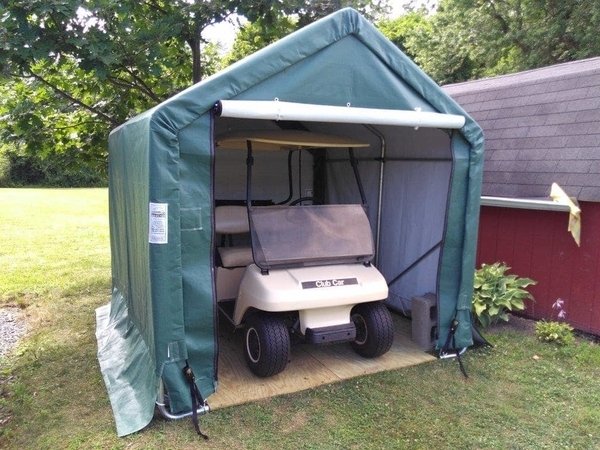While most of us would love to play golf year-round, unfortunately that’s not always possible depending on where in the world you live.
In Australia, golf can easily be played for all 12 months of the year – even in winter, there are few places across the nation that get cold enough to create enough snow that would prevent you from teeing it up.
However, in nations like the United States and Canada, sleet and snow are synonymous with many parts of these countries, thus creating a golfing ‘off-season’.
If you’re someone who owns a golf cart, you’ll likely need to store your vehicle while it’s not in use during the colder, non-golfing months (a depressing thought, I know).
So, what steps do you need to take in order to store your golf cart safely during long periods of disuse?
When storing gas/petrol carts for long periods, it’s important to completely fill the tank (as this will prevent condensation forming) and drain the fuel line. Electric carts should be fully charged, with the battery placed in the ‘tow’ position to prevent discharge. Tires on all carts should be fully inflated, with the battery cells topped up with water before storing.
Along with following these steps, it’s also important to find a dry, safe place to store your cart (such as a shed) as this will reduce the chances of the battery and internal wiring being damaged by the elements.
Keep reading for an in-depth guide on how to correctly store your golf cart (along with answers to some other common questions relating to storing your vehicle outside, or during winter).
Table of contents
How to store an electric golf cart for long periods
Electric golf carts are without doubt the most common type used across the world, and it will only be a matter of time before fuel-powered carts become extinct.
Below are the key steps you should take when storing your electric cart for long periods, such as the off-season.
Step 1: Fully charge your battery
All lead acid batteries will self-discharge when not used for an extended period of time.
Because of this, you want to completely charge your golf cart before moving it into storage.
Once you have done this, you need to flick the ‘tow’ switch underneath the seat to the ‘tow’ position as this will ensure other electric components do not drain the battery’s charge while the cart is not being used.
When it comes time to remove your cart from storage, if the battery does not run or charge it’s likely your battery voltage dipped below the minimum level needed for your charger to kick on – you may need to drop your battery into a mechanic to recharge it appropriately.
Step 2: Disconnect the battery and attach maintainer
Following this, you should disconnect the negative battery terminal to avoid parasitic draw from accessories or electric components.
This can be done without tools by adding a quick disconnect switch to your golf cart, such as the GOGONFLY Battery Switch that you can get cheap off Amazon.
Next (and this step is additional, but very helpful), it’s recommended to attach a 36-volt maintainer – such as the SUHU Trickle Charger – by clamping it onto the main positive and negative connectors.
The maintainer can sit for extended period of times and turn on/off when sensing a change in the battery’s charge, and ensuring it stays charged.
Note: Only use a maintainer if storing your golf cart in warm, dry storage environments; when using them on batteries stored outside, they can charge for too long and cause water to evaporate from the battery cells, leading to damage.
Step 3: Fill battery cells to correct levels
This is a particularly important step to ensuring your battery maintains its charge for as long as possible.
Remember, batteries contain acid and are extremely volatile, so it’s vital you wear eye protection and gloves when topping up the battery cells.
When it comes to filling your batteries, the first thing to do is open the caps to your battery (they should either just pop off, or twist off with little force).
Using distilled water only, take a funnel and place it in each cell of the battery.
Pour the water in slowly and carefully – you only want the water level to be a quarter-inch above the lead cells, which should be visible once you remove the cap.
Too full can cause acid to splash out and corrode the connections and cables, while too little can damage the cells.
Step 4: Fill your tires to the right pressure
The final step is to fill your golf cart’s tires to the maximum pressure listed for the cart (if you don’t know these details, search the vehicle model online and you should find the answer).
Doing this will prevent the likelihood of getting ‘flat spots’ in the tires, which can result in a rough, bumpy ride when heading out for your first few rounds after removing your cart from extended storage.
However, if you do experience this, don’t worry as these flat spots usually even themselves out after extended use.
How to store a gas/petrol golf cart for long periods
In the United States, petroleum is commonly referred to as ‘gas’. In Australia, it’s called ‘petrol’. It’s important for clarity that for this article, I’m talking about the same thing.
Below are the key steps to complete before storing your petrol-powered golf carts for long periods, which differ slightly from an electric cart.
Step 1: Fill your tank correctly
It’s important to fill your cart’s gas tank with non-ethanol fuel before placing it into storage to allow as little room as possible for condensation.
This will prevent gumming, or other deterioration of the fuel.
If you don’t have ethanol-free fuel, it’s still recommended to fill the tank but also adding an additive such as Yamaha’s Fuel Med or Stabil’s Marine Formula.
Step 2: Drain the fuel line
Next, if you have a carburetted cart, turn the valve on top of the fuel tank to the ‘off’ position and rev the engine in neutral until the engine no longer runs.
Doing this will clear the fuel line and prevent any residue building up or settling in the line while the cart remains idle in storage.
After completing these tasks, also go through and complete the steps detailed above regarding disconnecting the battery, filling the battery cells to the appropriate levels, and filling the tires to the correct pressure as these procedures apply to both electric and fuel-powered carts.
Can golf carts be stored outside?
Golf carts can be stored outside for short periods – a few days at a time – provided the weather is favourable and the vehicle is getting regular use. If you are placing your golf cart into prolonged storage, it’s recommended to leave it in a dry, warm enclosed space such as a shed or garage.
Like all vehicles, golf carts are comprised of electrical components that don’t do so well when left outside in the elements for extended periods.
If you are planning on sidelining your golf cart for months at a time, it’s certainly advisable to find adequate shelter to keep it dry.

Can you store a golf cart outside in the winter?
It’s not recommended to store a golf cart outside during winter as the extreme cold can freeze the battery cells, causing them damage (sometimes beyond repair). Instead, your cart should be stored in a warm, dry location over the winter to protect it from the elements.
With winter comes everything golf carts hate – dew, condensation, rain, hale and in extreme climates, snow.
If you leave your vehicle outside, you run the risk of any, or all, of these conditions causing significant damage to the battery and electrics in the cart – most of which can be avoided by simply storing the cart under cover.
What size shed do I need for a golf cart?
A standard 2-seater golf cart has the dimensions of 92 inches by 48 inches by 80 inches, while a super-sized 6-seater has dimensions of 144 inches by 48 inches by 80 inches. A golf cart shed needs to have adequate space surrounding vehicles of these sizes in order to allow easy access, but also space to house a charger (for electric carts).
Obviously, golf carts take up far more room on your property than a push cart (either remote controlled or manual) might, meaning some thought must be given regarding how to store them.
If you have a garage or even garden shed that is of decent size, you should have no problem storing your golf cart out of the elements – however, it’s important the shed has power so that you can charge the cart and connect a maintainer during extended periods of storage.
Final message
Preparing your golf cart for storage – and keeping it in a suitable environment while idle – is crucial for prolonging its life.
These vehicles aren’t cheap to purchase, or replace, so it’s important you follow the proper steps when packing them away over the off-season to ensure they restart without any issues when the time comes to take them back out onto the course.


